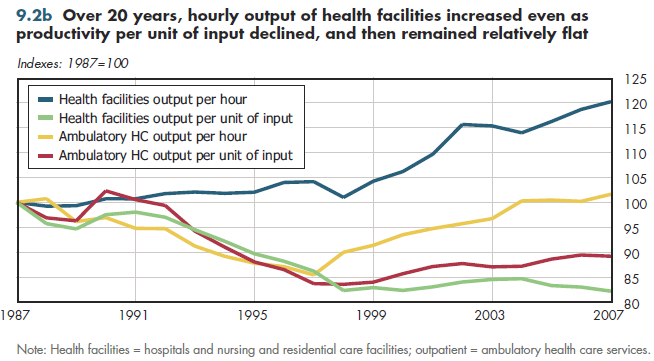Ambulatory care output per unit of input was less in 2007 than it had been 20 years earlier (figure 9.2a). This is only one way of measuring productivity. Even in terms of output per hour, productivity in the ambulatory health care industry generally declined into the 1990s and generally rose thereafter. Even so, hourly productivity in 2007 was almost identical to its 1987 level. In contrast, productivity grew much more steadily in the private sector overall during the same period. Hourly productivity climbed by approximately 60 percent while output per unit of input increased approximately 25 percent.

In health facilities, hourly productivity has tended to increase, especially since 1998. However, when capital inputs are taken into account, output per unit of input actually had fallen more by 2007 in health facilities than in ambulatory health care services (figure 9.2b).

In the goods-manufacturing portion of the health industry, productivity trends are somewhat like those in the private economy overall. For manufacturers of medical equipment, the growth in hourly productivity and output per unit of input has easily exceeded the average levels experienced in the private sector (figure 9.2c).

In pharmaceuticals, 2007 output per hour was approximately at the same level as in 1987. However, this combines a sharp drop in productivity in the late 1980s followed by rather steady annual increases thereafter. Pharmaceutical manufacturers saw a slight increase in output per unit of input at the start of this period, with generally falling productivity levels thereafter.
Falling productivity does not connote falling output. Output was increasing in all these health subsectors during this time. Because inputs into production also were increasing either more quickly or at approximately the same rate, productivity growth generally was more anemic in health care than elsewhere in the private economy. However, readers are cautioned that estimates of productivity are highly dependent on accurate price measurement. Accurate estimates of price changes are more challenging for health care than for most other goods and services because for the latter, it is easier to account for changes in quality.
Download PowerPoint versions of all figures.
- Author's calculations.
- Department of Labor. Bureau of Labor Statistics.










